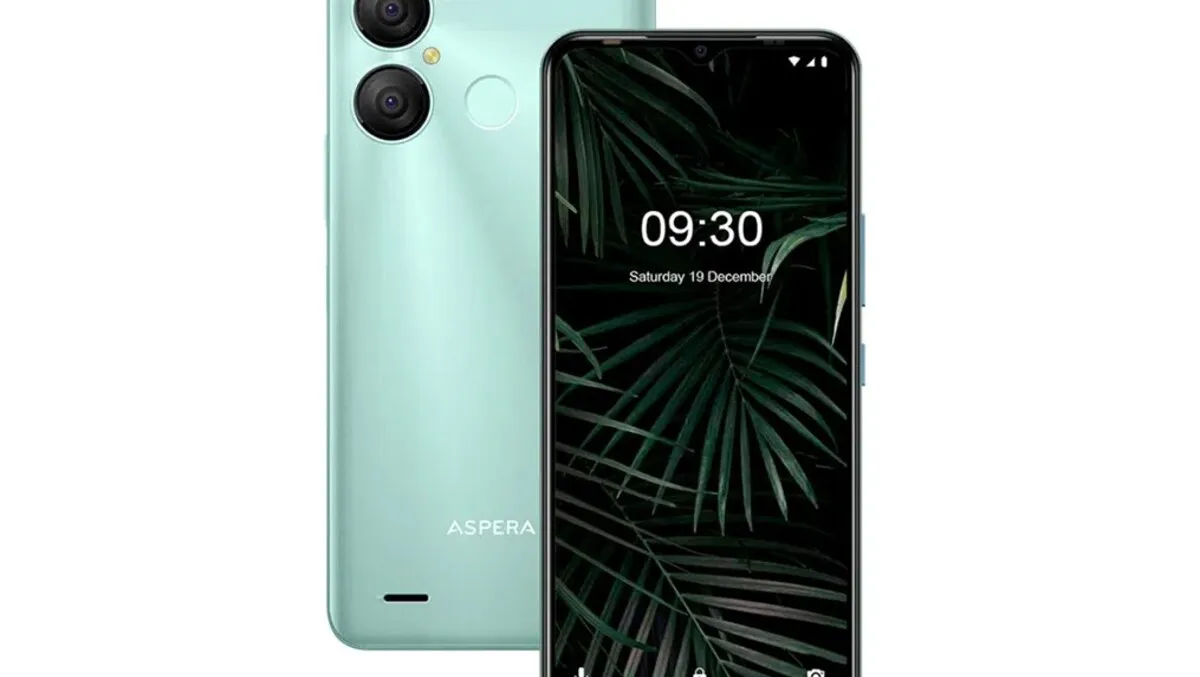The Aspera AS8 is a 6-inch Australian budget smartphone powered by Android 13 Go Edition. The folks at Aspera sent over a mint-coloured handset for us to test.
I've looked at a few phones from Aspera in the past. By and large, they offer very good value for money for devices that come in at almost throwaway prices. The rugged Aspera R9, with looks that suggest it could withstand a week rattling around in a toolbox, is a favourite of mine. These are phones for folks who don't see the need to splash out a fortune on something likely to get lost or broken.
I've never been one to get excited about a mobile phone. The things started as an expensive dalliance for sales types before becoming low-rent status symbols until settling down as an, unfortunately, essential life tool. These days, everybody needs a mobile phone.
But not everybody wants to or has the money to spend the best part of a grand on a handset. This is where Aspera comes in.
With many budget smartphones, even the untrained eye could spot that there was perhaps something cheap about them. A bit too light; perhaps the screen is just not slippery enough, or the handset is just a little too flexible in your grip.
I got none of that with the Aspera AS8. If someone handed it to me without seeing the logo, I'd have no idea that I was holding an AUD$150 phone. And that's 90% of the battle won, right there.
In the box, you get a comprehensive manual, the handset, a USB Type-C to Type-A cable and charging plug, a pair of wired earbuds, a gel case, and a 4000mAh battery. Somewhat of a novelty in this age of sealed-in devices, where a battery failure means shipping it off somewhere, with the AS8, you have to carefully remove the back of the phone to insert the battery.
The back of the case is a bit plasticky, so you do need to be careful to locate the little groove at the bottom right of the screen. With the back removed, I noticed two SIM slots. That's right, this AS8 is a dual-SIM phone (2x nano SIMs), which is amazing, to be honest. There's also a MicroSD slot. Unfortunately, having a removable battery/back cover means that the phone isn't waterproof, but does that really matter?
For connectivity, there's a USB Type-C port for charging and data transfer, a 3.5m audio jack, 4G and 3G mobile data, Wi-Fi, and Bluetooth 5.0 LE. You can also use the phone as a Wi-Fi hotspot. There's even a built-in FM radio.
The phone is powered by a SC9863A1 octa-core (8x1.6GHz) processor. There's 2GB of RAM and 32GB of storage. If applications need more memory, 1GB of storage can be used as virtual memory. Storage can be expanded by up to 128GB via a MicroSD card.
Some extra goodies come in the form of facial recognition and a fingerprint reader on the back of the phones. It's also NFC capable of increasingly popular tap-and-go payments from your phone.
There is a 5-megapixel front-facing camera and 8MP and 0.0MP cameras at the rear. The phone offers all the usual settings. You can just point-and-click or drive into the pro settings, manually adjusting focus, shutter speed, ISO, etc. There's the option for panoramic shots and portrait settings. The camera can shoot video at 30 frames per second at 1080p,720p, and 480p. There's also the option to shoot timelapse video. The video and picture quality is pretty uncompromising for a cheap phone, especially if you take a bit of time with the comprehensive settings.
The 6.3″ HD+ IPS display has an 18:9 aspect ratio. On a white screen, there's a little bit of vignetting around the edges, but overall, the image is crisp and clear. I had no problem watching movies on the phone (even using the built-in speakers).
The phone runs on Google's Android 13 Go Edition. This slightly cut-down version of the Android operating system is common for budget and entry-level phones with less memory. The OS uses optimisations to allow applications to run faster on lower-spec technology. For most, the difference will be imperceivable, but a few standard apps have been replaced with their "Go" equivalents that use less of the phone's resources.
Compared to my regular phone, there's no doubt that the Aspera is slower, particularly at startup. But it's not a dealbreaker. On the whole, I can't fault the user experience at all. It ran all the essential apps I needed and, of course, worked well as an actual phone.
The only evidence of a budget build quality I could distinguish was a slight rattle coming from the top of the phone if knocked. The plastic rear of the case is cleverly disgusted by the included gel cover. There's also a factory-fitted screen protector.
The Aspera AS8 hides its status as a budget phone exceedingly well. The low price makes it perfect for those with no desire or ability to invest heavily in what is, unfortunately, an essential device in the modern world. It's also the perfect first phone for a child, with Google providing all the necessary parent restrictions to accompany the low price and fairly robust construction.
If you are after a fully functional budget smartphone that doesn't look or feel like a budget smartphone, the Aspera AS8 is worth a look.



